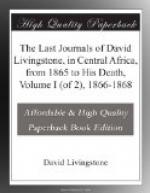24th September, 1866.—We went only 2-1/2 miles to the village of Marenga, a very large one, situated at the eastern edge of the bottom of the heel of the Lake. The chief is ill of a loathsome disease derived direct from the Arabs. Raised patches of scab of circular form disfigure the face and neck as well as other parts. His brother begged me to see him and administer some remedy for the same complaint. He is at a village a little way off, and though sent for, was too ill to come or to be carried. The tribe is of Babisa origin. Many of these people had gone to the coast as traders, and returning with arms and ammunition joined the Waiyau in their forays on the Manganja, and eventually set themselves up as an independent tribe. The women do not wear the lip-ring, though the majority of them are Waiyau. They cultivate largely, and have plenty to eat. They have cattle, but do not milk them.
The bogs, or earthen sponges,[25] of this country occupy a most important part in its physical geography, and probably explain the annual inundations of most of the rivers. Wherever a plain sloping towards a narrow opening in hills or higher ground exists, there we have the conditions requisite for the formation of an African sponge. The vegetation, not being of a heathy or peat-forming kind, falls down, rots, and then forms rich black loam. In many cases a mass of this loam, two or three feet thick, rests on a bed of pure river sand, which is revealed by crabs and other aquatic animals bringing it to the surface. At present, in the dry season, the black loam is cracked in all directions, and the cracks are often as much as three inches wide, and very deep. The whole surface has now fallen down, and rests on the sand, but when the rains come, the first supply is nearly all absorbed in the sand. The black loam forms soft slush, and floats on the sand. The narrow opening prevents it from moving off in a landslip, but an oozing spring rises at that spot. All the pools in the lower portion of this spring-course are filled by the first rains, which happen south of the equator when the sun goes vertically over any spot. The second, or greater rains, happen in his course north again, when all the bogs and river-courses being wet, the supply runs off, and forms the inundation: this was certainly the case as observed on the Zambesi and Shire, and, taking the different times for the sun’s passage north of the equator, it explains the inundation of the Nile.
25th September, 1866.—Marenga’s town on the west shore of Lake Nyassa is very large, and his people collected in great numbers to gaze at the stranger. The chief’s brother asked a few questions, and I took the occasion to be a good one for telling him something about the Bible and the future state. The men said that their fathers had never told them aught about the soul, but they thought that the whole man rotted and came to nothing. What I said was very nicely put by a volunteer spokesman, who seemed to have a gift that way, for all listened most attentively, and especially when told that our Father in heaven loved all, and heard prayers addressed to Him.




